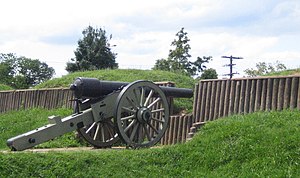Fort Stevens (Washington, D.C.)
| Fort Stevens | |
|---|---|
| Washington, D.C. | |

Ft. Stevens now includes several Civil War-era cannons.
|
|
| Coordinates | 38°57′51″N 77°01′44″W / 38.96417°N 77.02889°W |
| Site information | |
| Owner | National Park Service |
| Site history | |
| Built | 1861 |
| Materials | Earthwork |
Fort Stevens was part of the extensive fortifications built around Washington, D.C., during the American Civil War.
The fort was constructed in 1861 as "Fort Massachusetts" and later enlarged by the Union Army and renamed "Fort Stevens" after Brig. Gen. Isaac Ingalls Stevens, who was killed at the Battle of Chantilly, Virginia, on September 1, 1862. In 1861, it had a perimeter of 168 yards and places for 10 cannon. In 1862, it was expanded to 375 yards and 19 guns.
It guarded the northern approach to Washington, D.C., the Seventh Street Turnpike. By 1864 Fort Stevens was one part of a thirty-seven mile-long arrangement of fortifications, consisting of sixty-eight forts intended to defend the capital.
The fort was constructed as a part of a defensive ring around Washington. Following the Union defeat at Bull Run, Congress voted to augment the city's defenses, which consisted of a single fort (Fort Washington) twelve miles to the south on the Potomac. (Eventually, "68 forts, 93 batteries, 20 miles of rifle pits, and 32 miles of military roads surrounded the capital and Washington became the most heavily fortified city in the world.")
In September 1861 Union troops took possession of a property owned by a free black family Elizabeth Proctor Thomas and her siblings at the Seventh Street Turnpike, seeing it as "an ideal and necessary location for a fort." The soldiers ultimately destroyed her home, barn, orchard, and garden to build what was then named Fort Massachusetts.
Elizabeth Thomas would later often repeat the story that she was watching union soldiers with a baby in her arms weeping as they destroyed her house when "a tall, slender man dressed in black approached her and said, 'It is hard, but you shall reap a great reward.'" Many listening to her story held that the man was President Abraham Lincoln.
Thomas would have to fight for compensation for damage and loss of her property and was eventually awarded $1,835 in 1916, a year before her death.
After being delayed by the Battle of Monocacy, Maj. Gen. Jubal Early's Confederate forces advanced on Washington, D.C. The cavalry attacked Fort Stevens in the Battle of Fort Stevens on July 11 and July 12, 1864. They were delayed stealing horses in Damascus, Maryland, and staying overnight near Rockville, In response, Major General George Thomas ordered the District of Columbia Militia into the service of the Union army.
...
Wikipedia

